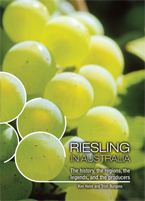Riesling in Australia, Ken Helm and Trish Burgess
| Title of book: | Riesling in Australia |
| Author: | Ken Helm and Trish Burgess |
| Publisher: | Winetitles |
| Publication date: | 2010 |
| ISBN | 978 0 9756850 6 8 |
| Pages: | 152 |
| Price: | AUD$ 49.50 |

Riesling in Australia, Ken Helm and Trish Burgess
Subtitled “The history, the regions, the legends, and the producers”, and that is exactly how the book is organised in its treatise on arguably the finest grape variety for still white wine.
The first chapters are quite technical, thus, for example, the book usefully opens by setting the record straight on the true riesling moniker. Given that riesling used to be one of the most renowned and revered grape varieties in the then wine-making world, (i.e. Europe), it’s probably no surprise that riesling became a generic term to describe any white wine (a misnomer possibly now assumed by chardonnay).
Despite the confusing nomenclature, the authors begin by attempting to unravel the origins of riesling in Australia, region by region, searching historical documents for the earliest references to both viticulture in general and the variety in particular, before going on to outline the status quo of riesling in 21st century Australia, which country has the second-largest plantings of this variety in the world (a long way behind Germany).
Chapters on riesling viticulture by Louisa Rose, the chief winemaker at Yalumba, and on riesling flavour by Dr. Leigh Francis, a sensory research manager at the Australian Wine Research Institute (AWRI), help put riesling in perspective. The variety’s minority stake in Australian viticulture is highlighted at just 2% of the national crush, as is riesling’s need for cool temperatures to preserve the variety’s delicate aromatics. Francis easily embraces the monoterpenes and norisoprenoids of riesling’s delicate aromatics like old friends in an excellent chapter accessibly analysing riesling flavour.
The not so technical part of the book looks at the influence of nineteen Australian riesling luminaries including the Barrys, Jeffrey Grosset, Andrew Hood, and Andrew Pirie. From the individual stories these pioneers provide, some sort of framework for the Australian riesling paradigm can be pieced together, both growing and making. Passion and single-mindedness become evident as no small ingredients.
Given riesling’s “ability to reflect the region which retaining true varietal expression” (Louisa Rose), not so much attention was given to identifying and explaining regional variation in Australia for the grape variety, which, as riesling is grown in almost all of Australia’s GIs (geographical indications), must be considerable. Those GIs cover a broad range of climates.
However the book does finish by listing some 550 producers who make riesling in Australia, which would enable a leisurely personal voyage of style and region discovery to be made.



